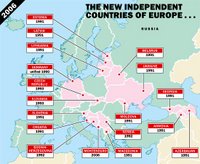What seems to have been a measure by some Western powers to punish Slobodan Milosevic and Serbia may have backfired. Then, during the Balkan war, the USA and most of the European countries did little or nothing to aid the break away republics, with the possible exception of Germany's support of Slovenia.
And so we were all forced to witness the razing of Dubrovnik and the rape of Sarajevo.
After the first Balkan war, Slobodan made a huge mistake, he attacked the Kosovo Liberation Army formed by what the international media likes calling "ethnic" Albanians. What Slobo could not understand was just how powerful the Albanian lobby was in Washington, and soon NATO was dropping bombs all over what was left of Yugoslavia. And it was Belgrade's turn to be demolished.
Kosovo was not "liberated" by the NATO, but the Clinton administration seeing its failure managed to introduce a clause that would give Montenegro the chance to secede from the new version of Yugoslavia. That way, in a very sly way, the USA was providing Kosovo with an escape route. All this just to apparently punish Serbia for their refusal to let go of Slovenia, Croatia, Macedonia and Bosnia in a peaceful manner. In reality, the referendum clause was a way to satisfy the Albanian lobby.
Well, the USA and its NATO allies also made a mistake. They allowed Montenegro to gain its independence through a referendum, setting a legal precedent that they won't be able to deny to all the other nations without statehood in Europe and quite possibly around the world (Hawaii anyone?).
So, Times on Line published this piece about the issue:
The Times
Calls for freedom make the jigsaw of Europe more complicated than ever
MOST people would struggle to point out Pridnestrovskaya Moldavskaya Respublika on a map, let alone pronounce it.Those who can, know it as a hotbed of smuggling, the site of a vast Soviet-era weapons dump, or perhaps the home of Sheriff Tiraspol football club.
But this tiny sliver of land, known in English as Transdniestr, is the latest European enclave to make a bid for independence following Montenegro’s decision to declare statehood last month.
Igor Smirnov, Transdniestr’s “President”, has announced that its 550,000 people will vote in a referendum in September on whether to seek formal independence from Moldova.
“The recent example of Montenegro proves that a referendum is becoming a norm for solving conflicts,”, said Mr Smirnov, 64, a former metalworker.
In the unlikely event that Transdniestr wins independence, it would become Europe’s 19th new country since the collapse of communism in 1989, and the fragmentation goes on.
From the Basques of Spain to Turkey’s Kurds, there are minorities who yearn for a country of their own, and Montenegro’s example has kindled hopes that even tiny enclaves in Europe’s forgotten corners can still become viable states.
The fear is that declarations of independence by mini-states could spark fresh instability in already unstable regions.
In the Balkans, Montenegro’s independence drive is likely to be followed by Kosovo, a predominantly ethnic Albanian province of Serbia. That could spark fresh moves by the ethnic Serb Republika Srpska to break away from Bosnia, and Herceg-Bosna’s Croats to join Croatia.
In the Caucasus, Russia is still struggling to contain the separatist rebellion in Chechnya. Georgia is split by breakaway regions in Abkhazia and South Ossetia. There is still no resolution to Nagorno-Karabakh, a disputed enclave in Azerbaijan that is controlled by Armenia.
Not even Western Europe is immune. Nationalists in Northern Ireland still seek a united Ireland. Scotland is in theory closer to independence that at any time since the Act of Union with England 300 years ago. Separatist movements are active in the Basque country, Corsica, Sardinia and Italy.
As for Europe’s newest would-be state, Transdniestr broke away from Moldova in 1990 and the two sides fought a war in 1992 that left more than 1,500 people dead. Although never recognised internationally, it has close ties to Russia, which helped the ethnic Russians in the war and has maintained 1,500 troops there.
Officially, they are there to keep the peace and guard a stockpile of 40,000 tonnes of weapons stored there in case of a Nato invasion. In reality, this remains Moscow’s westernmost strategic outpost — a bulwark against the expanding EU and Nato. It is also a haven for money-laundering, smuggling and illegal weapons sales.
Mr Smirnov runs it as a personal fiefdom, financed by local oligarchs and propped up by nostalgia for the Soviet Union. It has its own currency based on the old Soviet rouble, uses the old Soviet Moldovan flag, and stages annual Soviet-style military parades. Police wear uniforms bearing the hammer and sickle.
There is no direct telephone link to Moldova and no mobile network. Shop windows display tawdry goods from the 1970s and 1980s. The only redeeming feature is Moldova’s only FIFA-approved football stadium, which is home to the country’s top football club, Sheriff Tiraspol.
Peace talks, mediated by the Organisation for Security and Co-operation in Europe, have stalled over Transdniestr’s refusal to accept autonomy within a Moldovan state. Russia has backed the referendum.
Karel De Gucht, the Belgian Foreign Minister and OSCE chairman, has said that there is no legal basis for a referendum and urged both sides to return to the negotiating table.
But wait, what about that map I said I love?
Well, at the bottom of the article they provide the link to two maps. This one:
And this one:
Darn, do I love the second map.


No comments:
Post a Comment